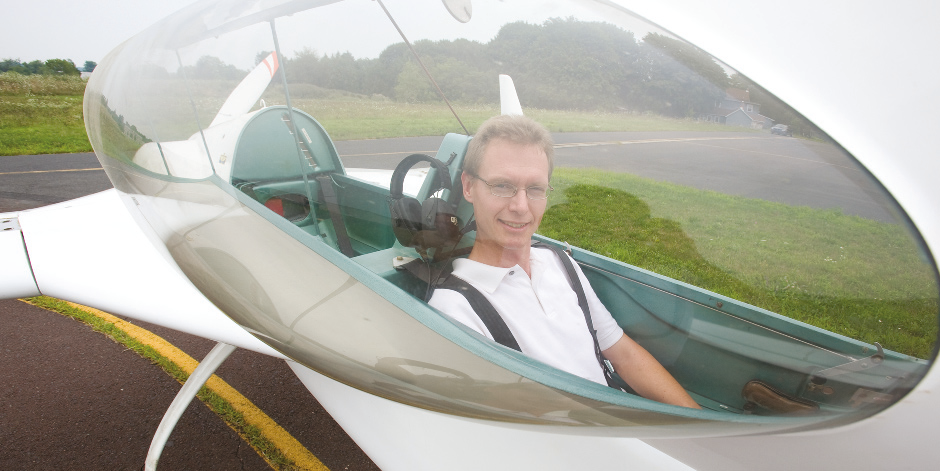Joachim Grenestedt glanced both ways down the long road on Lehigh’s athletic campus, then strode back to his Go Kart in the empty parking lot.
Not a car in sight. The coast was clear.
Moments earlier, Grenestedt’s student had tested a new titanium brake caliper with a thin membrane that replaced all moving parts. After installing the caliper in the Go Kart, the student had gently coaxed the vehicle to 30 mph, then braked.
The caliper had held. Mission accomplished.
But Grenestedt saw greater potential in the new brake. Taking the controls of the Go Kart, he zoomed off around the parking lot. He hit 30 mph, 40, 50 – and braked. Again, the caliper held. Grenestedt grinned and climbed out of the Go Kart.
Early to the water
Joachim Grenestedt, professor of mechanical engineering and mechanics at Lehigh, began building wooden boats when he was 4. Three years later, his family bought a yacht and explored the endless islands off Sweden’s Baltic coast. As a teenager, Grenestedt tried out catamarans and remote-control race boats.
As an adult, Grenestedt has cultivated an appreciation for lightweight composite materials: carbon fibers, glass fibers and complex materials configured in honeycomb and sandwich patterns.
“Composite materials are very light, very strong and easy to make into complex shapes,” he says. “The lightness improves speed and fuel efficiency. And the material doesn’t rust or fall apart.”
In the 1990s, Grenestedt helped design the Visby, a Swedish Navy stealth ship, which, at 239 feet in length, was the largest carbon-fiber structure ever built.
A growing repertoire
In 2004, with funding from the Office of Naval Research (ONR), Grenestedt designed and built a 20-foot model of a new hybrid ship hull whose stainless-steel frame was covered by composite sandwich panels. The panels and the epoxy bonding them to the frame sustained loads up to 40 percent above design load.
Last year, Grenestedt tested a larger, 35,000-pound hybrid hull specimen. Using Lehigh’s 5-axis CNC router, he built composite panels with a corrugated fiberglass “skin” infused over a foam core. These lightweight panels outperformed heavy, ½-inch-thick nonmagnetic stainless steel, as well as conventional (non-corrugated) composite sandwich panels.
“We subjected the specimen to 300,000 cycles of fatigue at loads up to 20 percent above design loads,” Grenestedt says. “A lot of cracks formed in the steel, but the lightweight composite sandwich panels remained intact.”
Grenestedt is now building a 28- foot-long high-speed boat with the same steel-composite hybrid concept. He and his students will fit the boat with a 425-hp V8 engine, then run it on the water at speeds of 70 mph.
“Nobody would commit to building a bigger ship using this hybrid concept until it has been tried in real seas,” he says.
The speedboat will also serve as a “slamming” test bed.
“Slamming is a hydrodynamic impact, wave against boat,” Grenestedt says. “It’s a random event that occurs at high speeds. We haven’t figured out how best to design against it, nor do we have the computational capabilities to analyze it accurately.”
Grenestedt will test various materials – carbon and glass fibers, stiff and soft – in the boat’s bottom panels. He will test different asymmetrical configurations of the panels
“By doing back-to-back comparisons, replacing panels as we go, we will see very quickly how each kind of panel behaves.”
Bound for Bonneville
Next year, Grenestedt will compete in the 125cc-engine category for land-speed racing “streamliner” motorcycles at the Bonneville Speedway in Utah. He is building a streamliner out of prepreg carbon and glass fibers, vacuum-infused carbon fibers, wet-laid glass fibers, foam cores sandwich, honeycomb sandwich and single skin.
In a departure from convention, he is designing his streamliner to sit high off the ground, a fact he hopes will offer an aerodynamic advantage.
Just getting into the streamliner will be a challenge for Grenestedt, who is 6 feet, 4 inches tall. The streamliner is well under 4 feet high, and less than 2 feet wide at the driver’s shoulder.
“I’ll need to spend a few minutes stretching my neck and back before I squeeze myself into the ’liner,” he says.
He fully expects to break the world record of 151 mph for a 125cc vehicle.
“It’s a big challenge to go that fast with such a small engine. But we’ve got a serious shot. I think I’ll get it – sooner or later.”

